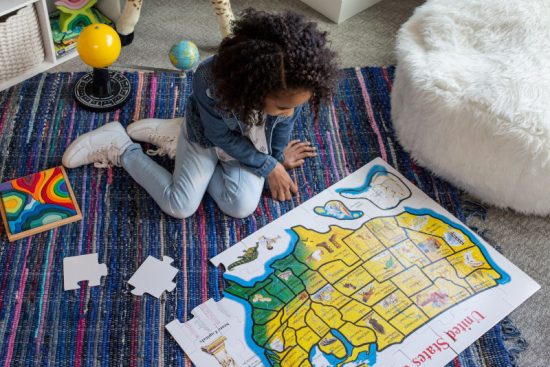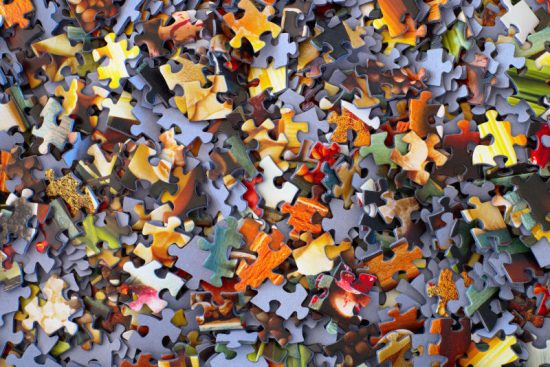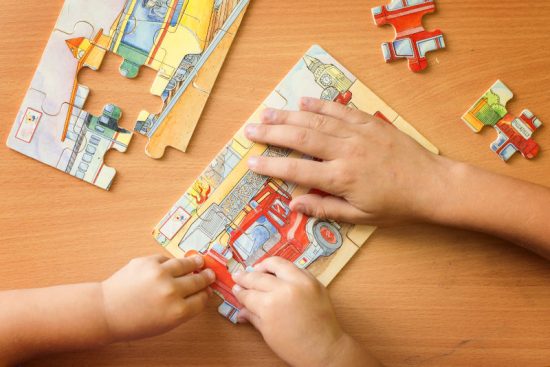This page may contain affiliate links. If you purchase something through one of the links, we may receive a commission at no extra charge to you. Still, we would include only products we actually trust and believe will be helpful for you.
Puzzles are a fantastic educational toy for children. They help to develop their problem solving, memory, patience and many other skills.
But in order for the kid to gain the maximum benefits from puzzles, they need to be taught.
So, how to go about teaching and encouraging your little ones to do puzzles?
Following are several tips you can follow to develop those puzzling muscles and the love of puzzles in your kid.
1. Introduce Puzzles Very Early
Kids will probably learn puzzles easier and quicker at a younger age, the earlier the better.
You can actually introduce knob puzzles with few pieces to kids at about 6 months old. By the age of 2, toddlers may start playing with jigsaw puzzles that include large pieces and a frame.
2. Switch to More Difficult Puzzles as Appropriate
Of course, raising the puzzle’s difficulty as the kid gets more experienced is quite important for them to further develop their puzzle skills. As a rule of thumb, if your child starts to do the puzzles without much thoughts or struggles, it’s probably time to inch up the difficulty level a bit.
This mainly includes a higher number of pieces and/or smaller size of pieces. It can also involve getting puzzles with less contrasting colors, switching from frame puzzles to floor puzzles, or maybe bringing puzzles that have an unconventional shape (e.g. circular) or irregular pieces (e.g. US states).

3. Make the Existing Puzzles More Challenging
Try to make it a bit more difficult for the child to assemble the puzzles. Some ways to accomplish this may include:
- Asking him to complete the puzzle without looking at the reference image
- Setting up a timer and telling the kid to finish the puzzle faster
- Letting him work on the puzzle after you remove a piece or two
4. Complete the Puzzle in Front of the Kid
It’s one thing to verbally explain to your kid how to do a puzzle and another to actually put the pieces together in front of him. They will learn much better after watching you complete the puzzle.
This method also provides the child with confidence and instills in him the belief that he also has the ability to assemble the puzzle by himself.
5. Match the Puzzle Image with the Child’s Interests
If the child loves dinosaurs, try to bring puzzles that include dinosaurs. If she likes ocean animals, then get her under-the-sea-themed puzzles. Maybe your kid likes a specific character such as Micky Mouse, ensure there are puzzles that include it.
In short, do your best to provide the kid with some puzzles that align with their interests. That will motivate them to learn and engage more with this educational toy.
6. Rotate the Puzzles that are Accessible to the Kid
Imagine the kid doing the same few puzzles over and over again for the whole year, they will probably get bored quickly. To minimize the possibility of that happening, simply make sure to rotate the puzzles that are accessible for your child at home from time to another (maybe every few months or so).
If you don’t want to buy too many puzzles, you can rent some from a toy library, your friends or other family members. A good number of puzzles to make available for the child to play with at any moment is around 4-5.

7. Ensure There is a Variety of Puzzle Images
In addition to rotating the puzzles, it helps significantly to have some variety of puzzle images all the time. Maybe get a puzzle that features jungle animals, another that includes vehicles, and perhaps another that has butterflies.
The more different puzzle pictures there are, the less likely the kid will get bored quickly from playing.
8. Work Together to Assemble the Puzzle
Getting on the floor with your kid in order to solve a puzzle helps to provide a lot of motivation for him.
As the child feels he’s supported by someone, he will be more encouraged to do his best in order to complete the whole puzzle. This is also an easy way to strengthen your family connection and spend extra quality & fun time with each other.
9. Provide Some Puzzle Clues as Needed
Even though it’s beneficial to physically help your kid in assembling the puzzle, that obviously shouldn’t be the norm. Instead, you should encourage the kid to try to do the puzzle alone without any assistance as much as possible.
In case you feel the kid has made a mistake or feel stuck, you can provide her with clues rather than intervene. For example, if they put together two pieces that don’t fit, you can say something like ‘is there something wrong here?’. If the child doesn’t know what to do next, you may suggest they continue at an easier spot (e.g. in the puzzle borders).
10. Run a Puzzle Competition to See Who’s Faster
Competition challenges are loved by kids since they get a chance to prove themselves and their abilities. This is something you can capitalize on as a parent to make your child work harder and refine their skills more while assembling puzzles.
Simply hold a contest between your family members where the winner is the one that put together their puzzle faster. This works quite well if you have more than one kid so they can compete with each other more squarely.

11. Teach the Kid Strategies for Solving Puzzles
It’s very crucial to teach your child different strategies for problem-solving, which they can use to complete the puzzles. Those techniques include the following:
Starting with Puzzle Borders
Beginning with the borders is probably the easiest way for kids to tackle a puzzle. This is especially helpful if the puzzle has no frame where the pieces go.
Matching Pieces by Color
You can teach the child to try to put together pieces that have similar colors. This works especially well when the puzzle colors have a high contrast such that they’re easy for little ones to differentiate.
Sorting Pieces by Object
A puzzle image will typically have several objects that are different from each other. The child can strategize by grouping together pieces that constitute a certain object (e.g. animal or tree). They can do this using the colors and patterns specific to the object.
Sorting Pieces by Section
For any puzzle, there will be sections with unique objects or colors that the kid can work on. For instance, the bottom-right corner of the puzzle may feature a big tree with some yellow birds.
Connecting Pieces that Fit
If the puzzle pieces are more uniquely cut, the kid can check which pieces go together based on their shape.
Please note that the above strategies are not exclusive and can be applied together e.g. the kid may use both the colors and objects to match the pieces.
Conclusion
There you have it, several great tips you can use to effectively teach your child to solve puzzles. You don’t have to use them all, just choose the ones that suit you the best.
These techniques will help to both develop the kid’s problem-solving skills and motivate them to play with puzzles without getting bored.
In case the list above seems to be long for you, then focus on the following four (which are probably the most important):
- Switch to more difficult puzzles as appropriate (#2)
- Make the existing puzzles more challenging (#3)
- Provide some puzzle clues as needed (#9)
- Teach the kid strategies for solving puzzles (#11)
If you want to learn about how to choose the right puzzle for your child, be sure to check out this article.



